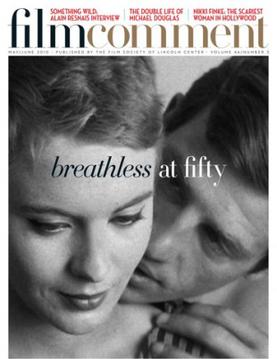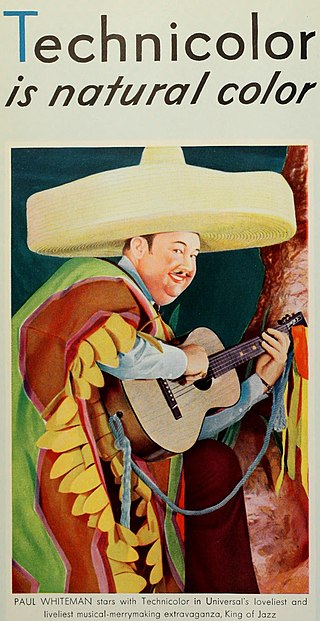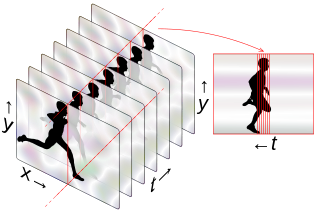
Pan and scan is a method of adjusting widescreen film images so that they can be shown in fullscreen proportions of a standard-definition 4:3 aspect ratio television screen, often cropping off the sides of the original widescreen image to focus on the composition's most important aspects.

Henry V is a 1944 British Technicolor epic film adaptation of William Shakespeare's play of the same title. The on-screen title is The Chronicle History of King Henry the Fift with his battell fought at Agincourt in France. It stars Laurence Olivier, who also directed. The play was adapted for the screen by Olivier, Dallas Bower, and Alan Dent. The score is by William Walton.

Michael James Aleck Snow was a Canadian artist who worked in a range of media including film, installation, sculpture, photography, and music. His best-known films are Wavelength (1967) and La Région Centrale (1971), with the former regarded as a milestone in avant-garde cinema.

Richard Serra was an American artist known for his large-scale abstract sculptures made for site-specific landscape, urban, and architectural settings, whose work has been primarily associated with Postminimalism. Described as "one of his era's greatest sculptors", Serra became notable for emphasizing the material qualities of his works and exploration of the relationship between the viewer, the work, and the site.

Cyril Raker Endfield was an American film director, who at times also worked as a writer, theatre director, magician and inventor. Born in Scranton, Pennsylvania, he worked in the New York theatre in the late 1930s before moving to Hollywood in 1940. His film career was interrupted by the Hollywood blacklist, and he resettled in London at the end of 1951. He is particularly known for The Sound of Fury/Try and Get Me! (1950), Hell Drivers (1957) and Zulu (1964).

Time-lapse photography is a technique in which the frequency at which film frames are captured is much lower than the frequency used to view the sequence. When played at normal speed, time appears to be moving faster and thus lapsing. For example, an image of a scene may be captured at 1 frame per second but then played back at 30 frames per second; the result is an apparent 30 times speed increase. Similarly, film can also be played at a much lower rate than at which it was captured, which slows down an otherwise fast action, as in slow motion or high-speed photography.

Macbeth is a 1948 American historical drama directed by Orson Welles. A film adaptation of William Shakespeare's tragedy of the same name, it tells the story of the Scottish general who becomes the King of Scotland through treachery and murder. The film stars Welles in the lead role and Jeanette Nolan as Lady Macbeth.
Emanuel Farber was an American painter, film critic and writer. Often described as "iconoclastic", Farber developed a distinctive prose style and set of theoretical stances which have had a large influence on later generations of film critics and influence on underground culture. Susan Sontag considered him to be "the liveliest, smartest, most original film critic this country has ever produced."
This article contains a list of cinematic techniques that are divided into categories and briefly described.
Structural film was an avant-garde experimental film movement prominent in the United States in the 1960s. A related movement developed in the United Kingdom in the 1970s.

The Magnificent Ambersons is a 1942 American period drama written, produced, and directed by Orson Welles. Welles adapted Booth Tarkington's Pulitzer Prize–winning 1918 novel about the declining fortunes of a wealthy Midwestern family and the social changes brought by the automobile age. The film stars Joseph Cotten, Dolores Costello, Anne Baxter, Tim Holt, Agnes Moorehead and Ray Collins, with Welles providing the narration.

Mitchell Camera Corporation was an American motion picture camera manufacturing company established in Los Angeles in 1919. It was a primary supplier of newsreel and movie cameras for decades, until its closure in 1979.

Wavelength is a 1967 Canadian-American short subject by experimental filmmaker and artist Michael Snow. Considered a landmark of avant-garde cinema, it was filmed over one week in December 1966 and edited in 1967, and is an example of what film theorist P. Adams Sitney describes as "structural film", calling Snow "the dean of structural filmmakers."

Film Comment is the official publication of Film at Lincoln Center. It features reviews and analysis of mainstream, art-house, and avant-garde filmmaking from around the world. Founded in 1962 and originally released as a quarterly, Film Comment began publishing on a bi-monthly basis with the Nov/Dec issue of 1972. The magazine's editorial team also hosts the annual Film Comment Selects at the Film at Lincoln Center. Due to the COVID-19 pandemic, publication of the magazine was suspended in May 2020, and its website was updated on March 10, 2021, with news of the relaunch of the Film Comment podcast and a weekly newsletter.

Entr'acte is a silent French Dada short film directed by René Clair. It premiered on 4 December 1924 at the Théâtre des Champs-Élysées in Paris as a prologue and entr'acte for the Ballets Suédois production of Relâche, based on a book by Francis Picabia, which had settings by Picabia, was produced by Rolf de Maré, and was choreographed by Jean Börlin. The music for both the ballet and the film was composed by Erik Satie.

Zorns Lemma is a 1970 American structural experimental film by Hollis Frampton. Originally starting as a series of photographs, the non-narrative film is structured around a 24-letter classical Latin alphabet. It remains, along with Michael Snow's Wavelength and Tony Conrad's The Flicker, one of the best known examples of structural filmmaking.

Technicolor is a series of color motion picture processes, the first version dating back to 1916, and followed by improved versions over several decades.

Strip photography, or slit photography, is a photographic technique of capturing a two-dimensional image as a sequence of one-dimensional images over time, in contrast to a normal photo which is a single two-dimensional image at one point in time. A moving scene is recorded, over a period of time, using a camera that observes a narrow strip rather than the full field. If the subject is moving through this observed strip at constant speed, they will appear in the finished photo as a visible object. Stationary objects, like the background, will be the same the whole way across the photo and appear as stripes along the time axis; see examples on this page.
This glossary defines terms that are used in the document "Defining Video Quality Requirements: A Guide for Public Safety", developed by the Video Quality in Public Safety (VQIPS) Working Group. It contains terminology and explanations of concepts relevant to the video industry. The purpose of the glossary is to inform the reader of commonly used vocabulary terms in the video domain. This glossary was compiled from various industry sources.
This glossary of motion picture terms is a list of definitions of terms and concepts related to motion pictures, filmmaking, cinematography, and the film industry in general.















